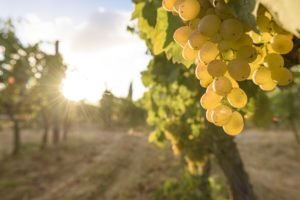Those who drink wine know well that there is more besides fruit. Today we will explain the various aromas and fragrances that characterize a wine. Let’s see aromas and scents of wine.
The perfumes or aromas of wine depend on over 220 odorous molecules present in wine in varying concentrations. These define the set of olfactory sensations of a wine: the bouquet. The most important volatile compounds, which give aromas and fragrances to wine, belong to the family of esters and terpenes, which are mainly responsible for fruity aromas.
The aromas and fragrances of the wine depend on various factors, the variety of grapes from which the wine is produced, the pedoclimatic conditions of the vineyard, the winemaking techniques and the type of aging, therefore the duration and the material used. The wine’s aromas and fragrances are also influenced by the state of conservation, the serving temperature, the type of glass used and the individual olfactory perception.

Wine aromas can be classified according to their origin or by association with known natural odors.
Based on the origin we have three types of wine aromas:
- Primary or varietal aromas. The typical aromas of the grape are considered. They are also called varietal aromas, because they are linked exclusively to the intrinsic olfactory characteristics of the grape. These odorous molecules are mainly present on the skin of the grape and most fall into the category of terpenes, which, as mentioned, are mainly responsible for the fruity aromas. These aromas are particularly intense and are characteristic of aromatic grape varieties.
- Secondary or fermentation aromas. They are aromas that wine acquires during fermentation (alcoholic and malolactic fermentation) or pre-fermentation processes. In this case the factors that determine the perfumes and aromas of the wine are the yeasts, bacteria and the vinification techniques adopted. Most of the volatile compounds developed in these phases are higher alcohols and aldehydes: these compounds enrich the wine with floral, fruity and vegetable notes. If the grape variety has a clearly recognizable aromatic identity, the primary aromas will remain evident, as in the case of aromatic grape varieties. In vines with a less incisive (or neutral) character, the secondary aromas of the wine will, on the other hand, have greater impact, making the grape variety of origin less recognizable.
- Tertiary or aging aromas. They are aromas that the wine acquires during maturation and refinement. In fact, wine is a material that continues to evolve both in the containers, in which it is refined before being put on the market (barrels, vats and amphorae), and in the bottle where it is left to age. The tertiary aromas are therefore typical of wines that require a long aging. Over time, the tertiary aromas of the wine take over the primary and secondary aromas, embellishing the bouquet with spicy, toasted, animal and ethereal notes.
By association with natural smells, however, we recognize these types of aromas:
- Fruity aromas: they are mainly primary (varietal), but also linked to fermentation processes (secondary). Descriptors of the fruity aromas of wine: apple, kiwi, grapefruit, peach, wild berries etc.
- Floral aromas: they derive both from compounds present on the skin of the berries (terpenes), and from fermentation processes, therefore they are attributable to both primary and secondary aromas. Descriptors of the floral aromas of wine: rose, violet, chamomile, hawthorn, jasmine etc.
- Balsamic aromas and aromatic herbs: they can be varietal (primary aromas), but also linked to fermentation processes (secondary aromas) or evolutionary (tertiary aromas). Descriptors of these aromas: dill, basil, rosemary, thyme, sage, fennel, mint etc.
- Spicy and toasting aromas: they are generally considered tertiary aromas, as they develop mainly during the aging of the wine in wooden containers. In fact, the wood releases many of the odorous molecules that enrich the aromatic spectrum of the wine. Descriptors of the spicy aromas of wine: anise, pepper, saffron, curry, vanilla, cloves, licorice etc. Descriptors of roasted aromas of wine: cocoa, coffee, tobacco, smoke, chocolate etc.
- Herbaceous and vegetable aromas: they are linked to the grape varieties (primary aromas) but may also have an origin in the fermentation processes (secondary aromas). Descriptors of these aromas: vegetables, hay, dry leaves, cut grass, undergrowth, truffle etc.
- Mineral aromas: they develop during the fermentation and evolution of the wine, and are therefore considered both secondary and tertiary aromas. The most common descriptors are: clay, brackish, flint, hydrocarbons etc.
We hope to have given you a good overview about aromas and scents of wine.
